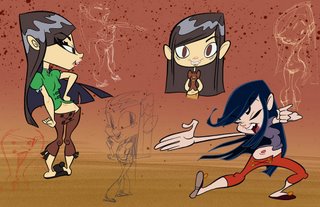
not to be confused with pee and poo colors
Many cartoon artists think there are only 7 colors:
And if you only looked at modern cartoons and video box covers it would be understandable why.
BUT!
There is a whole huge family of colors that I encourage my painters to add to their palettes.The neutral or natural colors. There are an infinite variety of these. They are made up of differing amounts of greys, browns and tiny amounts of the primary and secondary colors.
These kinds of colors are hard to name. Maybe that's why they are seldom used. Good artists can paint them, but there are no words to describe them, so execs can't say yes to something that doesn't have a simple word.
Now, for those of you who think only pink and purple are pretty colors, do you think these are ugly colors?
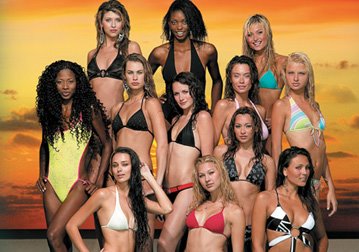 These colors are all covered by the one inadequate description: "Flesh Color". There are a zillion "flesh colors" and most people I know really like them.
These colors are all covered by the one inadequate description: "Flesh Color". There are a zillion "flesh colors" and most people I know really like them.Would your naked friends be prettier if they were these colors?:

Natural colors are rich and deep. They make things feel more real-even when used in an abstract way. I think this is what the "serious" cartoons are trying to acheive when they use "pee and poo" colors, but as you can see, natural colors don't have to look dingy and dirty. They can be quite beautiful.


 Here, Frank Frazetta's main color is a tan-but if you look close you will see it is made up of many shades and hues.
Here, Frank Frazetta's main color is a tan-but if you look close you will see it is made up of many shades and hues.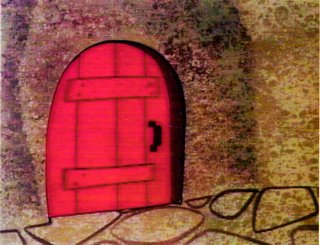 Here is a similar color scheme only simplified, from Slumber Party Smarty-a Yogi Bear cartoon, I think painted by Monteleagre in 1958. The browns on the wall are made up of different tints of brown-some yellowish brown, some reddish brown, some purplish brown.
Here is a similar color scheme only simplified, from Slumber Party Smarty-a Yogi Bear cartoon, I think painted by Monteleagre in 1958. The browns on the wall are made up of different tints of brown-some yellowish brown, some reddish brown, some purplish brown.The bright red door really pops from the BG without breaking up the image. If the red was next to another equally bright primary or secondary, it would clash and be garish and would break up the image.

This is a very unusual and striking limited palette of black/grey and light peach with a bit of yellow. Who would think of a color scheme like that? Nature would. Steal it!
 Here's a very limited palette of warm greys from FLCLY
Here's a very limited palette of warm greys from FLCLY In this Art Lozzi BG, the yellowish tan color is painted on the entire canvas and then the brown of the tree and fence, and the green grass are painted on top- in different degrees of opacity. This instantly brings all the colors into a harmonious family-and it is striking because it is an unexpected color scheme that you don't expect to see in cartoons.
In this Art Lozzi BG, the yellowish tan color is painted on the entire canvas and then the brown of the tree and fence, and the green grass are painted on top- in different degrees of opacity. This instantly brings all the colors into a harmonious family-and it is striking because it is an unexpected color scheme that you don't expect to see in cartoons.
 Sokol manages to use shades of subdued yellow and greyed browns to make a warm soft scene, without making it look depressing.
Sokol manages to use shades of subdued yellow and greyed browns to make a warm soft scene, without making it look depressing. If you use natural colors as your main scheme, you can then paint small details in brighter colors as in this scene of rocks and flowers.
If you use natural colors as your main scheme, you can then paint small details in brighter colors as in this scene of rocks and flowers.Look at all the interesting tints within the rocks-they aren't simply grey.
The whole little waterfall scene is framed by the green foliage.

Here is a similar color scheme-dark, greyed yet rich and full of life and beauty. Look at the two main tints in the rocks-the faces are deep reddish brown, the tops are warm grey.
Notice that the water isn't blue. Even the rainbow is not your typical My Little Pony rainbow.
 Here's what Frazetta can do with the same basic color scheme. Again, look close-nothing is made up of a single color, yet everything looks more like the substances they represent than the actual substances themselves.
Here's what Frazetta can do with the same basic color scheme. Again, look close-nothing is made up of a single color, yet everything looks more like the substances they represent than the actual substances themselves.

Grey and very light greyed-pink.

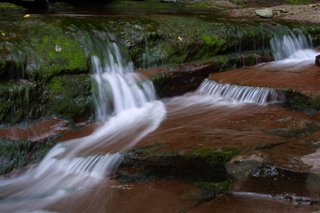

Here is a basic natural color scheme with spots of bright color. The bright colors really stand out against the neutrals.

Here's Mary Blair using that theory.
Her layouts and paintings are so well organized.
Many artists look at her stuff and glean that the secret to her style is to draw flat shapes, and then they proceed to draw an unorganized assembly of unrelated broken up flat shapes and then paint them pink, purple and green.
She uses an extremely thought-out hierarchy of shapes within shapes and levels of color shades and contrasts.
Everything ends up looking unique and readable and pretty-and cartoony.
 Art Lozzi is using a simple color palette that is also well organized. The color and value contrasts of the cabin, snow and sky are less then the contrast of the inside of the cabin.
Art Lozzi is using a simple color palette that is also well organized. The color and value contrasts of the cabin, snow and sky are less then the contrast of the inside of the cabin.That makes the inside stand out more and grab your attention.
If this scene was painted today, it would be unreadable.
Something like this:

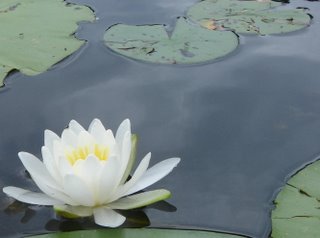
There are an infinite amount of greys. You put any color against grey and it will pop-like this flower.

Tortoise Wins By a Hair is painted by Johnny Johnston, who tends to use rich dark, subdued color schemes. Within his deep tones are many subtle color and value blends which makes the paintings and scenes really rich. Bugs' cool grey really reads against the warm greys on the wall and floor. Johnny painted his BGs in oil-a very rare and inconvenient medium for cartoons.
He also painted The Hep Cat (which has been totally ruined on the Looney Tunes DVD set-they actually removed color for once and most of the cartoon looks black and white now. It looks way better on the Laser Disks and VHS tapes).
He later worked for Tex Avery at MGM and painted such wonderful cartoons as King Size Canary. Take a look at how rich the colors are-especially in the back yard with the alley cats.
 See the hierarchy of colors? The BG is mostly grey tones - blueish purple grey sky and craters, then brownish grey rocks. The centaur is darker grey and blends from warm brownish greys to cooler greys up towards the man chest and head.
See the hierarchy of colors? The BG is mostly grey tones - blueish purple grey sky and craters, then brownish grey rocks. The centaur is darker grey and blends from warm brownish greys to cooler greys up towards the man chest and head.Even the girl's flesh is greyed, yet it is so much lighter that she pops out and appears more delicate.
Her red cape really pops.

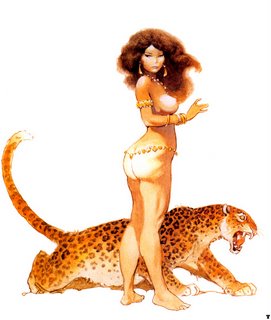

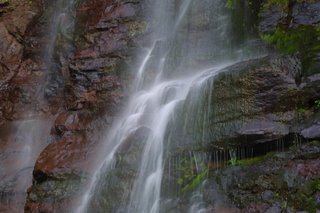






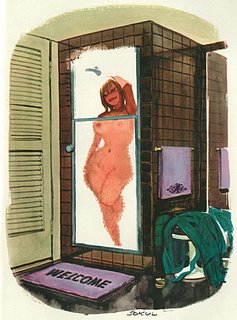
This kind of coloring takes a lot of skill and a keen eye and TASTE. Even if you know all the theories behind it, it doesn't mean everyone can combine subtle colors and make them beautiful. It takes a rare and special painter. Many painters try it and end up with mud.
It's too bad taste can't be learned. However if you are gifted with a tasteful eye, and you learn the theories and the ways great colorists combine and mix their colors maybe you can be another Mary Blair, Frazetta, Sokol, Wray or Dedini.
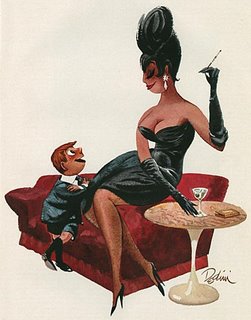

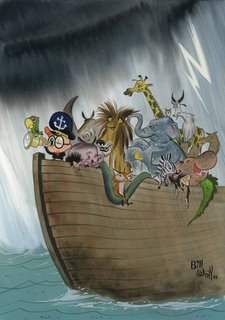
Here's a link to some great neutral background paintings from Woody Woodpecker cartoons:
WOODY NEUTRALS




